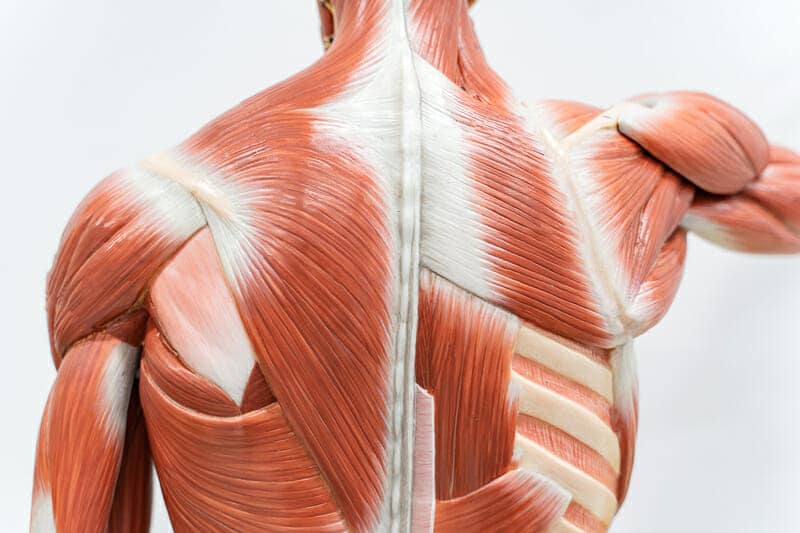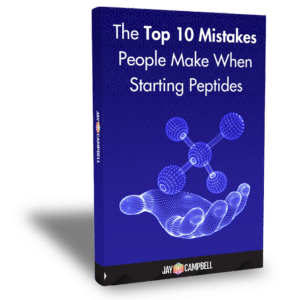Short of wanting to lose fat and gain a six-pack, there is no shortcut more often sought in the fitness industry than gaining as much muscle mass as possible.
People will turn to anything — I do mean ANYTHING — that will give them the physique of a Greek god, even if it literally destroys their health.
After all, nobody wants to hear they have a pre-determined maximum muscular bodyweight!
They’ll turn to steroids, SARMS, supplements, weird tricks they picked up in a bodybuilding magazine… and even peptides for muscle growth.
But be warned — unlike peptides for weight loss or peptides for immune system repair, we need to add in a lot of caveats and exceptions before you start using them.
Because the “best bodybuilding peptides”, as you’ll soon find out, don’t live up to the hype of the Internet.
Table of Contents
ToggleWhat Do Peptides Do for Muscle Growth?

In the context of becoming more muscular, peptides for muscle building are used to elicit the increased production of a naturally-produced biochemical in our bodies associated with the process of building and repairing new muscle tissue (i.e. anabolism).
Alternatively, they can be naturally or synthetically designed to trigger the inhibition of a biochemical that slows down muscle growth.
Target #1 for peptides is the secretion of growth hormone (GH):
“GH stimulates whole-body anabolism with protein accretion occurring in muscle and extra-muscular tissues. GHD [growth hormone deficiency] results in a reversible loss of aerobic capacity arising secondarily from impaired cardiopulmonary and haematological status. GH regulates the bioenergetics of muscle that enhance anaerobic performance. GH increases muscle strength by increasing muscle mass without affecting contractile force or fibre composition.”
Related to that, peptides for muscle mass commonly aim for insulin-like growth factor 1 (IGF-1):
“Most of the anabolic effects of GH are not direct metabolic effects on target tissues such as muscle, but are in fact the result of increased production of insulin-like growth factor I (IGF-I) from the liver (as a consequence of which the serum concentration of IGF-I is increased) as well as the production of IGF-I in tissues that are responsive to GH such as bone and muscle. In growing animals, in children, and in adults with GH deficiency, GH is very anabolic, causing increases in bone and muscle mass.” (Source)
“…IGF-1 is associated with muscle mass and strength development, it reduces muscle degeneration, prevents excessive toxin-induced inflammatory expansion, and increases the proliferation capacity of muscle satellite cells (MSCs). MSCs are key players in SM [skeletal muscle] regeneration, and IGF-1 is also produced in SM to control muscle growth in a paracrine/autocrine manner.
IGF-1 is also a biomarker of health and fitness; in fact, higher circulating IGF-1 concentrations are positively related to health factors associated with body structure and cardiovascular strength, and negatively related to body fat levels. Aerobic fitness and muscular stamina are positively associated with circulating IGF-1 concentrations” (Source)
Add in the fact that IGF-1 signaling activates increased protein synthesis for muscle mass maintenance via mTOR (mammalian target of rapamycin), and you can see why it’s such a popular target.
But aside from those two, we’re also discovering new peptides for muscle repair and their associated receptors that both play a pivotal role in the growth and size of skeletal muscle:
“The neuropeptide urocortin 2 (UCN2) and its receptor corticotropin releasing factor receptor 2 (CRHR2) are highly expressed in skeletal muscle and play a role in regulating energy balance, glucose metabolism, and muscle mass. The aim of this study was to investigate the effects of modified UCN2 peptides as a pharmaceutical therapy to counteract the loss of skeletal muscle mass associated with obesity and casting immobilization.”
And another popular peptides-driven avenue being pursued by scientists — although with little promise based on human clinical trials — is the inhibition of myostatin:
“Myostatin (growth differentiation factor 8, GDF8) is a Transforming Growth Factor-β (TGF-β) family member expressed predominantly in skeletal muscle. It functions as a negative regulator of muscle growth… Genetic deletion of myostatin has been associated with increasing muscle mass in mice, cattle, dogs, horses, and other species, indicating its evolutionary conservation”
“,..although myostatin inhibition in clinical trials have shown little in the way of side effects, there appears to be a disconnect between preclinical and clinical efficacy in muscular dystrophy. Six randomized, double-blinded, placebo-controlled (RDBPC) trials of various myostatin inhibitors in both pediatric and adult muscular dystrophies did not lead to further development primarily because of lack of efficacy”
Sure, we see positive results such as more skeletal muscle mass and increased grip strength in mice with brand-new peptides, but we are VERY far away from seeing the picture below manifest in humans:

I don’t have much more to say on myostatin, except to recommend this very recently published literature review if you want to see where the state of the science currently is with regard to myostatin inhibition.
Benefits of Peptides for Bodybuilding

Don’t be fooled by the “best peptides for muscle growth” title of this article… because although it sounds exciting, there are numerous caveats I need to put forth before I introduce them.
Caveat #1: Peptides For Bulking Aren’t The Best Compounds For Bulking
While the peptides I’m going to reveal can “indirectly” increase skeletal muscle tissue through GH secretion, IGF-1 secretion, and/or myostatin inhibition, muscle-building is not their primary selling point.
Many people get interested in peptides thinking they’re in the same efficacy range as products like SARMS(which are the worst things you could ever use and horrifically destructive to cellular health) and anabolic-androgenic steroids (AAS).
In reality, these peptides are far better at preventing catabolism (i.e. muscle breakdown) and shortening your recovery time.
The “gains” you’ll see are transient at best and simply will not compare to the real deal.
As one bodybuilder said on a forum, “Let the peptides heal you and the anabolics grow you”.
There’s a good reason why the real mass-gaining monsters aren’t promoting therapeutic peptides.
What they’re going for is pharma-grade GH and IGF-1 because they know both work infinitely better than peptides for muscle growth.
And even then, this entire ordeal is far more expensive and time-consuming compared to a half-assed yet tried-and-true cycle of “eat clen, tren hard, and anavar give up”.
Not to mention the prospect of IGF-1 and GH building muscle in healthy individuals, not GH-deficient individuals, is looking dubious at best.
Caveat #2: Peptides For Muscle Growth Are NOT Magic Pills
Those of you who have been around the fitness industry since the start of 2010 may remember the “pyramids” that went viral:

Although very simple in their design, they were a serious game-changer that finally got fitness gurus to stop overthinking and overcomplicating everything.
For the first time in a long time, people finally came to an agreement on what was most important and least important for transforming your physique and athleticism.
Which brings me back to the main question: What DO peptides do for bodybuilding if they aren’t the most effective way to build muscle mass?
They are at the very tippy top of the red nutrition pyramid in the image above.
In the context of muscle-building, I’d go as far as to argue they are no more important than the cherry on top of a sundae.
Without a fully optimized lifestyle of smart weightlifting, regular cardio, and dialed-in nutrition, peptides will do exactly jack shit for you.
Don’t expect any miracles. These are more of an extra push toward muscle size and definition once you’ve put in the real work.
Caveat #3: Using Peptides to Build Muscle is Illegal in Sports
You probably saw this coming but I’m going to repeat myself here for completion’s sake.
If you plan to use any of these peptides for muscle growth at all, you’d better not be a competitive athlete:
“The use of some peptide hormones, including those with anabolic or strength enhancing actions, are prohibited under section S2.2 of the WADA Prohibited List. The list of S2 agents grows each year, and even if a substance is not specifically listed, it may still be prohibited if it has “a similar chemical structure or similar biological effect(s).”
Athletes and support personnel can easily check the prohibited status of individual peptide hormones on GlobalDRO.com.”
And don’t think you can try and cheat the system, as the sports authorities have gotten VERY good at peptide detection:
“Peptide testing varies from drug test to drug test, but it’s generally detectable for up to 1-3 months after use… It detects the presence of peptides in urine by measuring the concentration of specific markers in the sample.
“A urine test measures the concentration of drugs in your urine and will only be positive if you have recently used drugs…. metabolites are formed when your body breaks down these substances into smaller molecules that are then excreted in your urine. These metabolites stay in your system for a few days before they are flushed out by urination, so urine tests usually detect them within 2-3 days after use.”
“Hair follicle testing is designed to detect long-term drug use rather than short-term use like with a urine test. Hair follicle testing detects drugs that were in your system at some point during its growth cycle, which is usually about 90-100 days. This means that any drug taken over this period would be detected in the test.”
As long as you’re ok with not being the next Olympic gold medal winner and can settle for being an elite-level biohacker in your personal life, have away at these peptides!
The Best Peptides for Muscle Building

There aren’t too many peptides for muscle growth in existence, mostly because building muscle is at best a secondary effect for these Golden Age agents.
If you read the in-depth articles linked within the respective section for each peptide, you’ll notice they are superior for conferring other biological benefits.
Nevertheless, here they are, and here’s how they can give you ‘that extra 1-2% boost’ in muscle growth you’re looking for!
Peptide #1: 5-Amino 1MQ
5-Amino 1MQ is very different (it’s actually a small molecule and not a peptide) from all of the other peptides here in that it does not rely on HGH, IGF-1, or myostatin production.
Rather, its primary mechanism is NNMT (Nicotinamide N-methyltransferase) inhibition, which comes with a whole slew of muscle-building benefits:
- Promotes regeneration of aged muscle cells
- Initiates repair of muscle damage
- Improves neuromuscular function
- Maximizes muscle fiber contraction
- Reduces delayed onset muscle soreness (DOMS)
Couple this with its simultaneous fat loss effects, and you have the perfect body recomposition peptide.
In fact, this is one of the only peptides I’ve used where I noticed visible lean muscle gain within 6-8 weeks of consistently using it.
To make things even better, this is the ONLY peptide on the list where the best method of administration is through an oral pill.
Out of all the peptides on this list, 5-Amino 1MQ is the most anabolic and the most reliable.
Peptide#2: CJC-1295
CJC-1295 is best known as a growth hormone-releasing hormone (GHRH), specifically the small structural fragment of the GHRH already in our bodies that directs GH production.
Your body has “pulses” that secret GH via somatotropes (i.e. GH-releasing cells), and these pulses determine both when GH is released and how much GH is released.
GHRH’s role in this situation is to dictate the frequency and timing of said pulses.
Or put another way, GHRH (and by extension CJC-1295) is responsible for GH production AND secretion.
Not much else for me to contribute here, except that I highly recommend the “drug affinity complex” (DAC) variation as it provides the peptide with a longer half-life in the body.
Out of all the synthetic GHRH molecules in existence, it provides the best balance between GH secretion and lack of side effects.
I highly recommend using this peptide along with Ipamorelin for maximal GH production and release, which you’ll learn about right now.
Peptide #3: Ipamorelin
Ipamorelin is known as a growth hormone-releasing peptide (GHRP), which may sound functionally similar to a GHRH yet plays a very different role.
A GHRP works by inhibiting the production of a molecule called somatostatin that regularly inhibits the release of GH.
Doing so allows the body to “increase” the size of the GH pulses while still mimicking how and when the body naturally produces/releases GH.
Like CJC-1295, there are many GHRPs in existence.
But Ipamorelin stands out in the following ways:
- Does not increase ghrelin production, meaning you won’t experience an increase in appetite
- SELECTIVELY targets GH without affecting production of cortisol, prolactin, follicle-stimulating hormone (FHS), or luteinizing hormone (LH)
- Will not impact the body’s natural “flow” of producing and releasing GH
While Ipamorelin and CJC-1295 may be decent at inducing anabolism on paper, you are much better off using them as fat loss and longevity agents.
Peptide #4: Follistatin 315/344
NOTE: This is copied and pasted from an email I wrote years ago. I have never used this peptide and have no intention to, nor do I endorse purchasing it from any of the vendors linked, but I am putting it here as no other peptide has come so far in inhibiting myostatin production.
Here’s a great background description of this amazing peptide:
“Follistatin, also called activin-binding protein, is found in nearly all tissues of vertebrate animals.
Its primary function is to neutralize members of the TGF-β family, which play fundamental roles in everything from growth and development to energy homeostasis and immune system regulation.
In particular, follistatin interacts with activin, which plays an important part in cell proliferation and cell death as well as in the immune response as it applies to wound repair.”
You may have heard about “Follistatin 344” or Follistatin 315”, which is because there are many different forms of follistatin:
- Follistatin 344: Most basic form, primarily used in gene therapy where specifically-designed viruses are used to help administer follistatin into the body… can be broken down into the forms seen below.
- Follistatin 315: Main form located in bloodstream, primarily targets muscle tissue
- Follistatin 300: Involved in re-shaping nerve connections
- Follistatin 288: Involved primarily in reproductive health, may have role in cancer cell development.
(I put the two links above to show you just HOW EXPENSIVE this therapeutic peptide is and hence is why it is very rarely used, NOT as an endorsement to purchase it from the linked sites)
And if you’re wondering what the numbers stand for, it’s the number of amino acids within the listed follistatin analog:
“The FST344 transcript gives rise to a protein precursor of 344 amino acids, which results in the mature 315 amino acid form after removal of the signal peptide.
A fraction of follistatin 315 is further converted to the 303 amino acid form by proteolytic cleavage at the C-terminus.
Signal peptide removal of FST317 leads to the mature 288 amino acid form of follistatin.”
The interest in Follistatin comes from its muscle-building properties:
“An extracellular regulatory protein, follistatin has been shown to bind myostatin and members of the transforming growth factor- beta family with high affinity.
Moreover, transgenic follistatin overexpression results in increased muscle mass and improved muscle function in vivo.
A potent inducer of muscle growth, follistatin gene ablation results in skeletal abnormalities and reduced muscle mass at birth”
Several studies have been done on follistatin, but they involve an Aden-associated virus (AAV) carrier:
- Increased muscle and strength in species ranging from mice to monkeys, no changes noted in organ pathology or reproductive capabilities
- Injection in quadriceps muscle of patients with Becker muscular dystrophy helped them walk further
- Increased lean mass of mice by 10% compared to the control group when injected once every 72 hours
- Follistatin injections well tolerated for 2+ years due to its effect on multiple signalling pathways, and not just targeting myostatin in isolation
- Intramuscular injection in primates did not produce abnormal changes in morphology or function of critical organs
- May improve muscle mass and function in patients with certain degenerative muscle disorders
But bear in mind that follistatin is FAR from a perfect therapeutic peptide.
Some of the reported side effects include excess heart strain, and potential weakening of tendons and ligaments.
There is a severe lack of clinical evidence in human patients, and some bodybuilding experts attribute Follistatin’s muscle-building effects to its concurrent appetite-increasing effects (i.e. you eat more, you gain more muscle while using anabolic steroids alongside Follistatin)
Not to mention it is BANNED by the WADA and their drug tests can easily differentiate exogenous follistatin from endogenous follistatin (the follistatin naturally produced by your body)
The dosing requirements I found for Follistatin seem to be something to the tune of 100mcg injected every day for 10 days straight.
I haven’t used Follistatin myself in any capacity, so I can’t personally comment on its effectiveness.
Peptide #5: PEG-MGF
NOTE: This is copied and pasted from an email I wrote years ago. I have never used this peptide and have no intention to, nor do I endorse purchasing it from any of the vendors linked, but I am putting it here as no other peptide has come so far in directly targeting IGF-1 production.
PEG-MGF (a.k.a. Pegylated Mechano Growth Factor) can be described in so many ways, but this summary I found way back does an excellent job of encapsulating everything it does in a few short sentences:
“As a splice variation of the IGF gene, PEG MGF is used for the increased creation and building of tissue, namely muscle.
PEG MEG (or pegylated mechano growth factor) promotes myoblast division which in turn causes the fusion and maturation of muscle tissue.
This process is vital for the growth of muscle in adults.
IGF-1 and MGF differ in the fact that the second stimulates myoblasts division via the activation of different receptors.
When it was firstly used, MGF was limited since the drug broke down in the body shortly after it was within the body.
Since then, researchers have been able to find a practical and ingenious way of preventing the breakdown through pegylation (the process in which MGF molecules were agglomerated to molecules of polyethylene glycol).
This permitted a protective coat to form and allowed the MGF to be carried through the circulatory system without breakage or losing its bioactivity or its efficiency in muscle building.
MGF that has gone through the pegylation process becomes more bioavailable and, when injected two to three times in a week, is capable of remaining concentrated for a long period.”
All of this is a fancy way of saying it increases protein synthesis for muscular hypertrophy and minimizes the effect you feel from delayed-onset muscle soreness (DOMS) after a brutal workout.
Some studies say it can also improve bone strength, boost your immune system, and regulate your cholesterol levels.
But this is still somewhat speculative and requires further investigation.
As for dosing recommendations, my final thoughts are still being formed.
But one protocol I found suggests 200 mcg injected subcutaneously once a day for 5 out of 7 days of the week.
PEG-MGF shows great promise for hormonally optimized people who want to add a big “boost” to their lean muscle gains.
Conclusion: The BEST Bodybuilding Peptides for Muscle Growth

The peptides for muscle growth featured in this article, while having great promise on paper, do not pan out in the real world with respect to the types of eye-dropping “before-and-after” transformations you normally see on social media.
Although they would *might* enhance the physique of someone who is older aging athlete and/or medically deficient in GH, it’s very difficult to quantify a real benefit for healthy well-trained young adults.
My recommendations would be as follows:
- Have 5-Amino 1MQ on deck for year-round use to maximize muscle gain and minimize fat gain regardless of whether you’re bulking or cutting
- Use Ipamorelin and CJC-1295 together once you’ve reached 15% body fat in a cutting cycle and need to melt the stubborn body fat faster
- If you have the financial and legal means to do so, use pharma-grade growth hormone instead of Ipamorelin and CJC-1295
- Experiment with Follistatin and PEG-MGF on your own time and let me know how it goes, knowing you are 100% responsible for what does (or doesn’t) happen
The first three peptides can be easily purchased at Limitless Life Nootropics if you’re looking for the BEST deal on both price and peptide purity.
Use code JAY15 at the checkout cart for 15% off!
But before you start injecting them into your body recklessly, make sure you first read the Top 10 Mistakes People Make When Starting Therapeutic Peptides FREE PDF!
Seriously, this book will save you a lot of wasted money and poorly spent time (not to mention preventing you from potential self-inflicted injuries).
And the emails I’ll send you after downloading the book contain an EXCLUSIVE 50% OFF code for my Therapeutic Peptides Course, so don’t miss out!
As always…
Raise Your Vibration To Optimize Your Love Creation!
PS – For private guidance in navigating the hopelessly confusing world of maximizing muscle gain without putting on pounds of fat at the same time, join The Fully Optimized Health Private Membership Group.
It’s your greatest opportunity to fully optimize your health and gain total access to me and my network of high-level men and women living their highest and best life.




